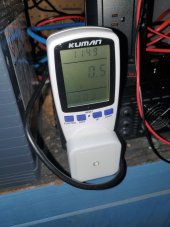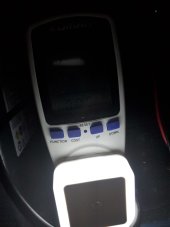I suggest a careful read of RCinFLA's Jan 8 post on this thread. I agree with most of what he stipulated. That said, I installed my MOES unit a couple of weeks ago and am very pleased with its performance. I have a Xantrex 600 W PSW inverter and it has run flawlessly for about 5 years. My current nominal load when the MOES switches between sources is less than 100 W (I run other things like a crock pot, recharge tool batteries, etc...during days with full sun) and non-inductive (no motors). I will be utilizing (and have in the past with my previous home-brewed Mains/Inverter DPDT relay based switch...one that does everything the MOES does but not set up to be variable disconnect/reconnect voltages) a submersible pump running off of this system which will cut over with the MOES (as it did before with my home brew). I think I will be ok (still) as my pump is only about 140 W and thus any surge is most likely small compared to say something switching at 8000 W (or more) AC window unit (or similar) especially if the compressor was on. Also, when I plug the pump back in my max load will be around 200 W when AC switches. I'm retired so able to futz around to make these things (manual load adjustments!) happen.
As for a solution...it's not super clear what this person did (below is a review I found on Amazon) but I think he's using the MOES device to trigger a stand-alone relay (he uses the terms "contactors" and "electrical/mechanical interlock" and I don't know what those are). Also has a picture but it's not super clear to me what he's doing. If anyone has an idea what he's using and how wired that might be helpful. To me it might just be using another relay controlled by the MOES unit. Note that he also cautions against inductive loads.
As a final note...as a teen I messed around with a lot of electronics and seem to remember messing around with a device called a timed delay relay. I think the one I had had a piece of metal that was heated when power applied which caused the metal to move and then make a contact, closing the circuit. No coil in the relay. Seem to recall it taking several seconds. Not sure if a more elegant technology exists (probably a 555 circuit of some sort!) but certainly a break before make circuit could be implemented. Problem with this is PCs/DVRs and similar don't like this. Case in point, we get the occasional 1-5 minute outages here and my DVR receiver takes about 20 minutes to go through all of its churning to come back up! Maybe fix (though probably expensive if more than one needed) is a UPS on anything that doesn't like >1 or 2 second loss of power.
link to review here:
https://www.amazon.com/gp/customer-...ef=cm_cr_dp_d_rvw_ttl?ie=UTF8&ASIN=B07F12RDZ2
Customer Review

mr cheese
1.0 out of 5 stars S K E T C H Y ... could be great but its a hazard just waiting to fail
Reviewed in the United States on September 10, 2020
Verified Purchase
It does work but this thing is not safe. For one there is no mechanical interlock. That is a must for two relays or contactors supplying different sources of power! It has a good chance of frying your inverter. Not if but when. It is a fire hazard for sure. The logic / solid state part of this device is great the screen and menus and ease of use. But were the actual power relays come into play is beyond sketchy. If you put inductive loads on this device it becomes a very very sketchy device. Inductive loads are very hard on contacts and often cause contacts to weld together. If this happens you have a fire hazard with this device. Trust me. I have 2 electrical degrees. Also never believe any power ratings from china! This would never pass UL listing test standards. Never!
**Update**
I found a work around solution for my needs with 2 contactors and an electrical/mechanical interlock from ABB. I used "public power" to energize the contactors. I wired it in reverse essentially. I used 1 hot wire only to the output and it feeds out of the inverter or public power to their respective contactors. This is way way safer.
The problem is if you use this as intended and the relay associated with the public power fails it will back feed to your inverter and destroy it. If you dont believe me take it apart and see for yourself. The solid state electronics(which work great!) Energize two form C relays that their commons produce the "hot" wire and neutral output. Please do the same or risk a relay failure which 100% will destroy your inverter. Just read the other 1 star reviews where this has already happened.





